The global retail paper bag market is valued at USD 12.8 billion in 2025 and is set to reach USD 23.7 billion by 2035, recording an absolute increase of USD 10.9 billion over the forecast period. This translates into a total growth of 85.2%, with the market forecast to expand at a CAGR of 6.3% between 2025 and 2035. The market size is expected to grow by approximately 1.9X during the same period, supported by increasing consumer preference for eco-friendly packaging solutions, growing retail sector expansion, and rising demand for premium shopping experiences across fashion, food service, and specialty retail sectors.
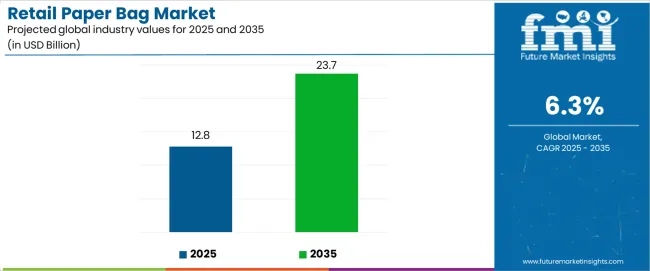
Between 2025 and 2030, the retail paper bag market is projected to expand from USD 12.8 billion to USD 17.4 billion, resulting in a value increase of USD 4.6 billion, which represents 42.2% of the total forecast growth for the decade. This phase of development will be shaped by increasing environmental awareness driving plastic bag alternatives, rising demand for customizable retail packaging, and growing adoption of premium paper bag solutions across luxury retail and e-commerce fulfillment operations.
Between 2030 and 2035, the market is forecast to grow from USD 17.4 billion to USD 23.7 billion, adding another USD 6.3 billion, which constitutes 57.8% of the ten-year expansion. This period is expected to be characterized by the advancement of biodegradable coating technologies, the integration of smart packaging features for brand engagement, and the development of ultra-lightweight paper bag designs across diverse retail categories. The growing emphasis on circular economy principles and waste reduction initiatives will drive demand for advanced paper varieties with enhanced durability capabilities, improved moisture resistance features, and superior printability characteristics.
| Metric | Value |
|---|---|
| Estimated Market Value (2025E) | USD 12.8 Billion |
| Forecast Market Value (2035F) | USD 23.7 Billion |
| Forecast CAGR (2025-2035) | 6.30% |
From 2030 to 2035, the market is forecast to grow from USD 17.4 billion to USD 23.7 billion, adding another USD 6.3 billion, which constitutes 57.8% of the ten-year expansion. This period is expected to be characterized by the advancement of water-resistant coating technologies, the integration of tamper-evident closure mechanisms for security applications, and the development of specialized bag designs for temperature-sensitive product categories. The growing emphasis on brand premium positioning and customer experience enhancement will drive demand for sophisticated varieties with enhanced aesthetic appeal, improved handle ergonomics, and superior load-bearing characteristics.
Between 2020 and 2024, the retail paper bag market experienced significant growth, driven by increasing awareness of environmental impact and growing recognition of paper packaging effectiveness in supporting brand image enhancement across retail and hospitality segments. The market developed as retailers recognized the potential for paper bags to deliver marketing advantages while meeting modern requirements for minimal environmental footprint and reliable carrying performance. Technological advancement in fiber technology and adhesive formulations began emphasizing the critical importance of maintaining cost competitiveness while extending bag durability and improving print quality across diverse retail applications.
Market expansion is being supported by the increasing global shift toward environmentally conscious packaging solutions and the corresponding transition toward biodegradable alternatives that can provide superior brand positioning while meeting consumer requirements for responsible shopping experiences and waste reduction practices. Modern retailers are increasingly focused on incorporating packaging solutions that can enhance brand differentiation while satisfying demands for consistent, reliably performing carriers and optimized customer experience practices. Retail paper bags' proven ability to deliver brand visibility, environmental benefits, and diverse customization possibilities makes them essential packaging components for fashion retailers and quality-conscious brand owners.
The growing emphasis on plastic reduction regulations and eco-friendly retail practices is driving demand for high-performance paper bag systems that can support green positioning and comprehensive environmental benefits across grocery stores, department stores, and specialty retail categories. Consumer preference for packaging solutions that combine functional excellence with environmental responsibility is creating opportunities for innovative implementations in both traditional and emerging retail applications. The rising influence of e-commerce growth and omnichannel retail strategies is also contributing to increased adoption of paper bags that can provide brand consistency and reliable performance characteristics.
The market is segmented by product type, material, handle type, end-use application, and region. By product type, the market is divided into kraft paper bags, white paper bags, colored paper bags, recycled paper bags, and specialty paper bags. Based on material, the market is categorized into virgin kraft paper, recycled kraft paper, coated paper, and other paper materials. By handle type, the market includes flat handles, twisted handles, die-cut handles, and rope handles. By end-use application, the market encompasses fashion & apparel, food & beverage, electronics & technology, books & stationery, and other applications. Regionally, the market is divided into North America, Europe, Asia Pacific, Latin America, Middle East & Africa, and other regions.
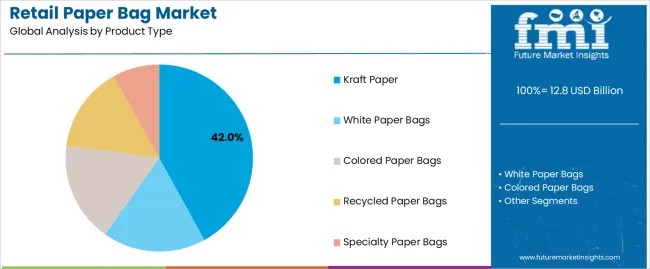
The kraft paper bags segment is projected to account for 42% of the retail paper bag market in 2025, reaffirming its position as the leading product category. Retailers and packaging facilities increasingly utilize kraft paper bags for their superior strength characteristics, established durability reputation, and essential functionality in diverse retail applications across multiple product categories. Kraft paper bags' proven load-bearing characteristics and cost-effective performance directly address retailer requirements for consistent carrying capacity and optimal packaging value in commercial applications.
This product segment forms the foundation of modern retail packaging patterns, as it represents the format with the greatest commercial versatility and established compatibility across multiple retail environments. Business investments in fiber quality improvement and manufacturing standardization continue to strengthen adoption among performance-conscious retailers. With consumers prioritizing durability and environmental responsibility, kraft paper bags align with both functional objectives and eco-conscious requirements, making them the central component of comprehensive retail packaging strategies.
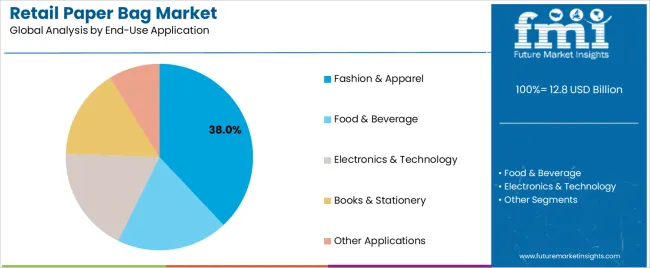
Fashion & apparel is projected to represent 38% of the retail paper bag market in 2025, underscoring its critical role as the primary application for quality-focused retailers seeking superior brand presentation benefits and enhanced customer experience credentials. Retail users and fashion brands prefer apparel applications for their established premium positioning, proven marketing effectiveness, and ability to maintain exceptional brand visibility while supporting diverse product offerings during various shopping experiences. Positioned as essential applications for discerning retailers, fashion & apparel offerings provide both brand differentiation excellence and customer satisfaction advantages.
The segment is supported by continuous improvement in printing technology and the widespread availability of customization options that enable brand distinction and premium positioning at the consumer level. Packaging companies are optimizing bag designs to support product protection and accessible luxury strategies. As printing technology continues to advance and consumers seek sophisticated shopping experiences, fashion & apparel applications will continue to drive market growth while supporting brand premiumization and customer loyalty strategies.
The retail paper bag market is advancing rapidly due to increasing environmental consciousness and growing need for plastic alternative solutions that emphasize superior brand presentation outcomes across retail segments and e-commerce applications. The market faces challenges, including higher costs compared to plastic alternatives, moisture sensitivity issues with certain applications, and supply chain pressures affecting raw material availability. Innovation in barrier coating systems and smart packaging technologies continues to influence market development and expansion patterns.
The growing adoption of retail paper bag systems in e-commerce packaging is enabling businesses to develop fulfillment patterns that provide distinctive brand presentation benefits while commanding consumer preference and enhanced unboxing experiences. E-commerce applications provide superior marketing properties while allowing more sophisticated customization features across various product categories. Retailers are increasingly recognizing the functional advantages of paper bag positioning for memorable customer interactions and brand-conscious delivery integration.
Modern retail paper bag manufacturers are incorporating advanced printing technologies, QR code integration systems, and interactive design elements to enhance customer engagement, improve brand connectivity, and meet commercial demands for omnichannel marketing integration. These features improve customer interaction effectiveness while enabling new applications, including loyalty program integration and social media engagement opportunities. Advanced technology integration also allows retailers to support data collection objectives and customer behavior tracking beyond traditional packaging operations.
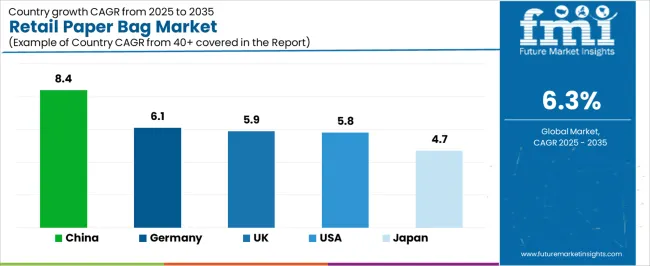
| Country | CAGR (2025-2035) |
|---|---|
| USA | 5.8% |
| Germany | 6.1% |
| UK | 5.9% |
| China | 8.4% |
| Japan | 4.7% |
The retail paper bag market is experiencing robust growth globally, with China leading at an 8.4% CAGR through 2035, driven by the expanding retail sector, growing middle-class consumption, and increasing adoption of eco-friendly packaging regulations. The USA follows at 5.8%, supported by rising environmental awareness, expanding e-commerce applications, and growing acceptance of premium retail experiences. Germany shows growth at 6.1%, emphasizing established manufacturing capabilities and comprehensive packaging innovation. The UK records 5.9%, focusing on premium retail applications and regulatory compliance. Japan demonstrates 4.7% growth, prioritizing quality paper solutions and technological precision.
The report covers an in-depth analysis of 40+ countries, with top-performing countries highlighted below.
Revenue from retail paper bag consumption and sales in the USA is projected to exhibit exceptional growth with a CAGR of 5.8% through 2035, driven by the country's rapidly expanding e-commerce sector, favorable consumer attitudes toward eco-friendly packaging, and initiatives promoting plastic reduction across major retail regions. The USA's position as a leading retail market and increasing focus on environmental packaging development are creating substantial demand for high-quality paper bags in both commercial and specialty markets. Major retail chains and e-commerce companies are establishing comprehensive packaging capabilities to serve growing demand and emerging market opportunities.
Demand for retail paper bag products in Germany is expanding at a CAGR of 6.1%, supported by rising packaging sophistication, growing retail requirements, and expanding manufacturing infrastructure. The country's developing technical capabilities and increasing commercial investment in paper technology are driving demand for paper bags across both imported and domestically produced applications. International packaging companies and domestic manufacturers are establishing comprehensive operational networks to address growing market demand for quality paper bags and efficient retail solutions.
Revenue from retail paper bag products in the UK is projected to grow at a CAGR of 5.9% through 2035, supported by the country's mature retail market, established shopping culture, and leadership in packaging aesthetics. Britain's sophisticated consumer base and strong support for premium retail experiences are creating steady demand for both traditional and innovative paper bag varieties. Leading retail brands and specialty stores are establishing comprehensive operational strategies to serve both domestic markets and growing export opportunities.
Demand for retail paper bag products in China is expected to expand at a CAGR of 8.4% through 2035, driven by the country's emphasis on retail sector expansion, manufacturing leadership, and sophisticated production capabilities for packaging requiring specialized quality varieties. Chinese manufacturers and retail brands consistently seek commercial-grade packaging that enhances brand differentiation and supports retail operations for both traditional and innovative consumer applications. The country's position as an Asian manufacturing leader continues to drive innovation in specialty paper bag applications and commercial production standards.
Revenue from retail paper bag products in Japan is anticipated to grow at a CAGR of 4.7% through 2035, supported by the country's emphasis on quality manufacturing, packaging precision, and advanced technology integration requiring efficient retail solutions. Japanese businesses and retail brands prioritize material reliability and manufacturing precision, making paper bags essential packaging for both traditional and modern retail applications. The country's comprehensive quality excellence and advancing packaging patterns support continued market expansion.
The Europe retail paper bag market is projected to grow from USD 4.2 billion in 2025 to USD 7.8 billion by 2035, recording a CAGR of 6.4% over the forecast period. Germany leads the region with a 32.0% share in 2025, moderating slightly to 31.5% by 2035, supported by its strong manufacturing base and demand for premium, technically advanced paper packaging products. The United Kingdom follows with 24.0% in 2025, easing to 23.5% by 2035, driven by a sophisticated retail market and emphasis on packaging innovation and environmental compliance. France accounts for 18.5% in 2025, rising to 19.0% by 2035, reflecting steady adoption of luxury retail packaging solutions and premium shopping experiences.
Italy holds 11.0% in 2025, expanding to 11.5% by 2035 as fashion retail innovation and specialty bag applications grow. Spain contributes 8.0% in 2025, growing to 8.5% by 2035, supported by expanding retail sector and premium product handling. The Nordic countries rise from 4.0% in 2025 to 4.2% by 2035 on the back of strong environmental adoption and advanced packaging technologies. BENELUX declines from 2.5% in 2025 to 1.8% by 2035, reflecting market maturity and regional consolidation.
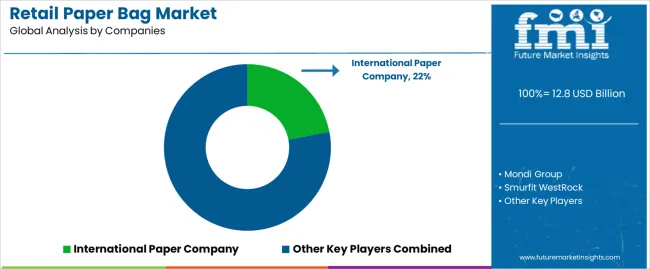
The retail paper bag market is characterized by competition among established paper manufacturers, specialized packaging producers, and integrated retail solution companies. Companies are investing in advanced fiber technologies, automated production systems, product innovation capabilities, and comprehensive customization networks to deliver consistent, high-quality, and reliable paper bag systems. Innovation in barrier coating technology, eco-friendly printing methods, and application-specific product development is central to strengthening market position and customer satisfaction.
International Paper Company leads the market with 22% share with a strong focus on fiber innovation and comprehensive paper solutions, offering commercial packaging systems with emphasis on manufacturing excellence and environmental heritage. Mondi Group provides specialized packaging capabilities with a focus on global market applications and manufacturing networks. Smurfit WestRock delivers integrated packaging solutions with a focus on retail positioning and operational efficiency. DS Smith specializes in comprehensive packaging manufacturing with an emphasis on commercial applications. Novolex Holdings focuses on comprehensive retail packaging solutions with advanced customization and premium positioning capabilities.
The success of retail paper bag systems in meeting commercial packaging demands, consumer-driven environmental requirements, and performance integration will not only enhance retail delivery outcomes but also strengthen global packaging manufacturing capabilities. It will consolidate emerging regions' positions as hubs for efficient paper production and align advanced economies with commercial retail systems. This calls for a concerted effort by all stakeholders -- governments, industry bodies, manufacturers, distributors, and investors. Each can be a crucial enabler in preparing the market for its next phase of growth.
How Governments Could Spur Local Production and Adoption?
How Industry Bodies Could Support Market Development?
How Distributors and Retail Industry Players Could Strengthen the Ecosystem?
How Manufacturers Could Navigate the Shift?
| Item | Value |
|---|---|
| Quantitative Units (2025) | USD 12.8 billion |
| Product Type | Kraft Paper Bags; White Paper Bags; Colored Paper Bags; Recycled Paper Bags; Specialty Paper Bags |
| Material | Virgin Kraft Paper; Recycled Kraft Paper; Coated Paper; Other Paper Materials |
| Handle Type | Flat Handles; Twisted Handles; Die-Cut Handles; Rope Handles |
| End-Use | Fashion & Apparel; Food & Beverage; Electronics & Technology; Books & Stationery; Other Applications |
| Regions | North America; Europe; Asia Pacific; Latin America; Middle East & Africa; Other Regions |
| Key Countries | United States; Germany; United Kingdom; China; Japan; and 40+ additional countries |
| Key Companies | International Paper Company; Mondi Group; Smurfit WestRock; DS Smith (profiled); Novolex Holdings; Other leading paper bag companies |
| Additional Attributes | Dollar sales by product type, material, handle type & end-use; Regional demand trends; Competitive landscape; Technological advancements in paper manufacturing; Barrier coating technology integration initiatives; Eco-friendly printing programs; Premium product development strategies |
The global retail paper bag market is estimated to be valued at USD 12.8 billion in 2025.
The market size for the retail paper bag market is projected to reach USD 23.7 billion by 2035.
The retail paper bag market is expected to grow at a 6.3% CAGR between 2025 and 2035.
The key product types in retail paper bag market are kraft paper , white paper bags, colored paper bags, recycled paper bags and specialty paper bags.
In terms of end-use application, fashion & apparel segment to command 38.0% share in the retail paper bag market in 2025.






Full Research Suite comprises of:
Market outlook & trends analysis
Interviews & case studies
Strategic recommendations
Vendor profiles & capabilities analysis
5-year forecasts
8 regions and 60+ country-level data splits
Market segment data splits
12 months of continuous data updates
DELIVERED AS:
PDF EXCEL ONLINE
Examining Market Share Trends in the Retail Paper Bag Industry
Europe Retail Paper Bag Market Trends – Growth & Forecast 2023-2033
Retail Glass Packaging Market Size and Share Forecast Outlook 2025 to 2035
Retail E-Commerce Packaging Market Size and Share Forecast Outlook 2025 to 2035
Retail Automation Market Size and Share Forecast Outlook 2025 to 2035
Retail Clinics Market Analysis – Size, Share, and Forecast Outlook 2025 to 2035
Retail Logistics Market Size and Share Forecast Outlook 2025 to 2035
Retail Displays Market Size and Share Forecast Outlook 2025 to 2035
Retail Sales of Legume Snacks in the UK Analysis - Size, Share & Forecast 2025 to 2035
Retail Sales of Kvass in Russia and CIS countries Analysis - Size, Share & Forecast 2025 to 2035
Retail Sales of Layered Verrine‑Style Desserts in France Analysis - Size, Share & Forecast 2025 to 2035
US Convenience Confectionery Retail Sales Analysis - Size, Share & Forecast 2025 to 2035
Retail Sales of Bergamot from Calabria in Italy Analysis - Size, Share & Forecast 2025 to 2035
Retail Sourcing And Procurement Market Size and Share Forecast Outlook 2025 to 2035
Retail Colocation Market Size and Share Forecast Outlook 2025 to 2035
Retail Warehouse Management Systems Market Size and Share Forecast Outlook 2025 to 2035
Retail Glass Packaging Industry Analysis in Europe and the Middle East and Africa - Size, Share, and Forecast 2025 to 2035
Retail Printers Market Growth - Trends & Forecast 2025 to 2035
Retail Vending Machine Market Analysis - Size, Share, and Forecast 2025 to 2035
Retail Analytics Market Analysis by Solution, Function, Enterprise Size, Deployment Model, Field Crowdsourcing, and Region Through 2035

Thank you!
You will receive an email from our Business Development Manager. Please be sure to check your SPAM/JUNK folder too.
Chat With
MaRIA